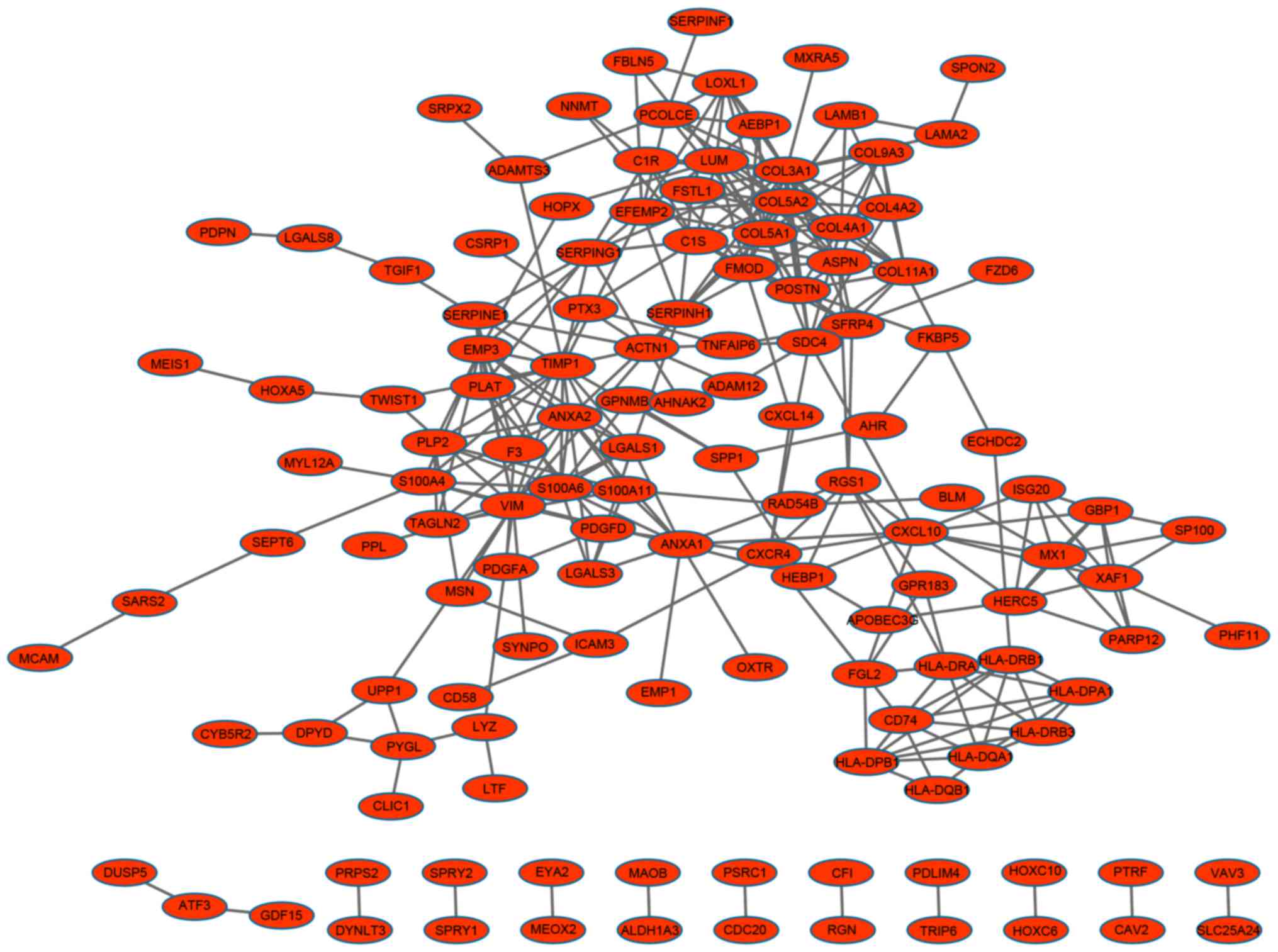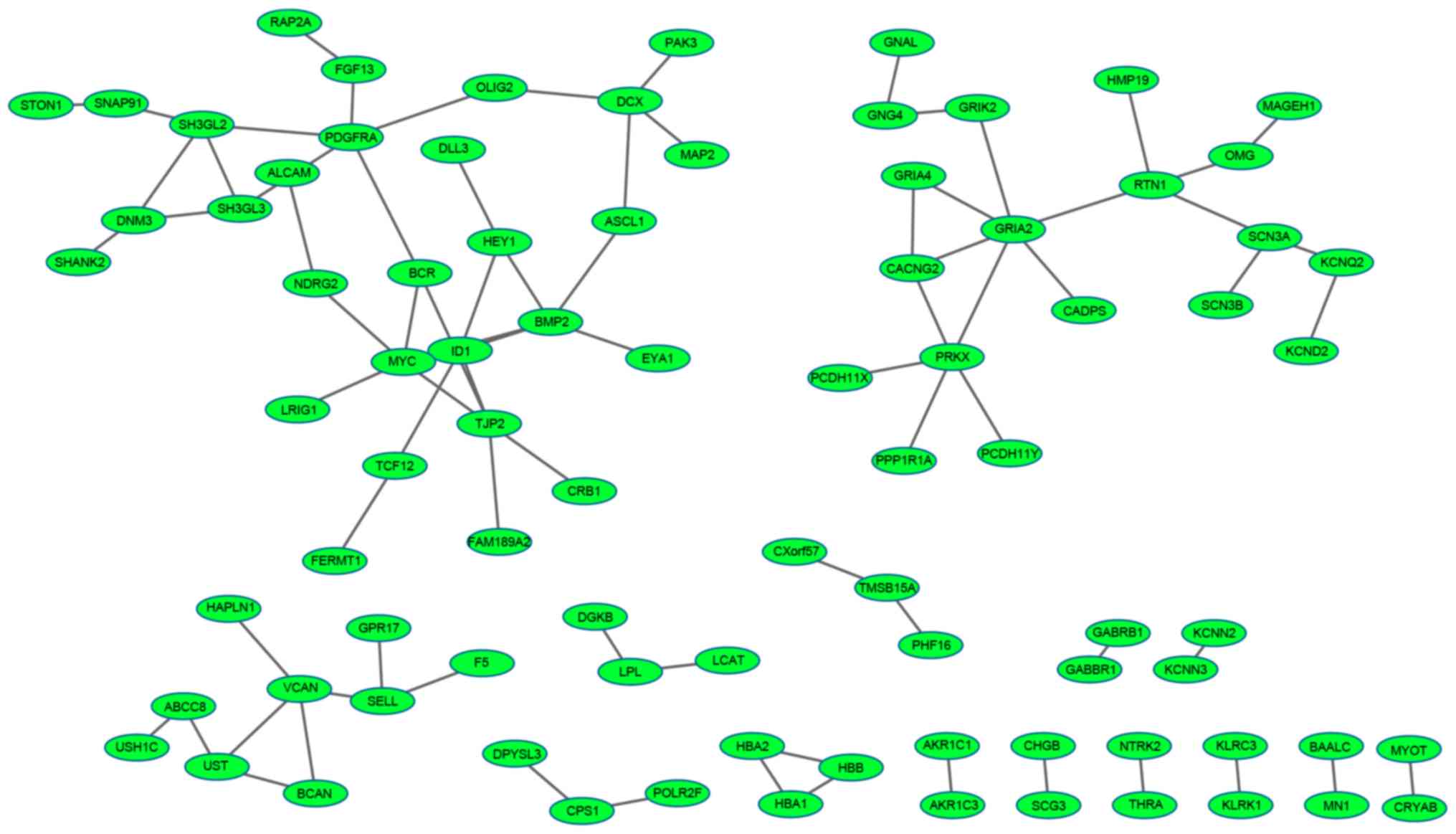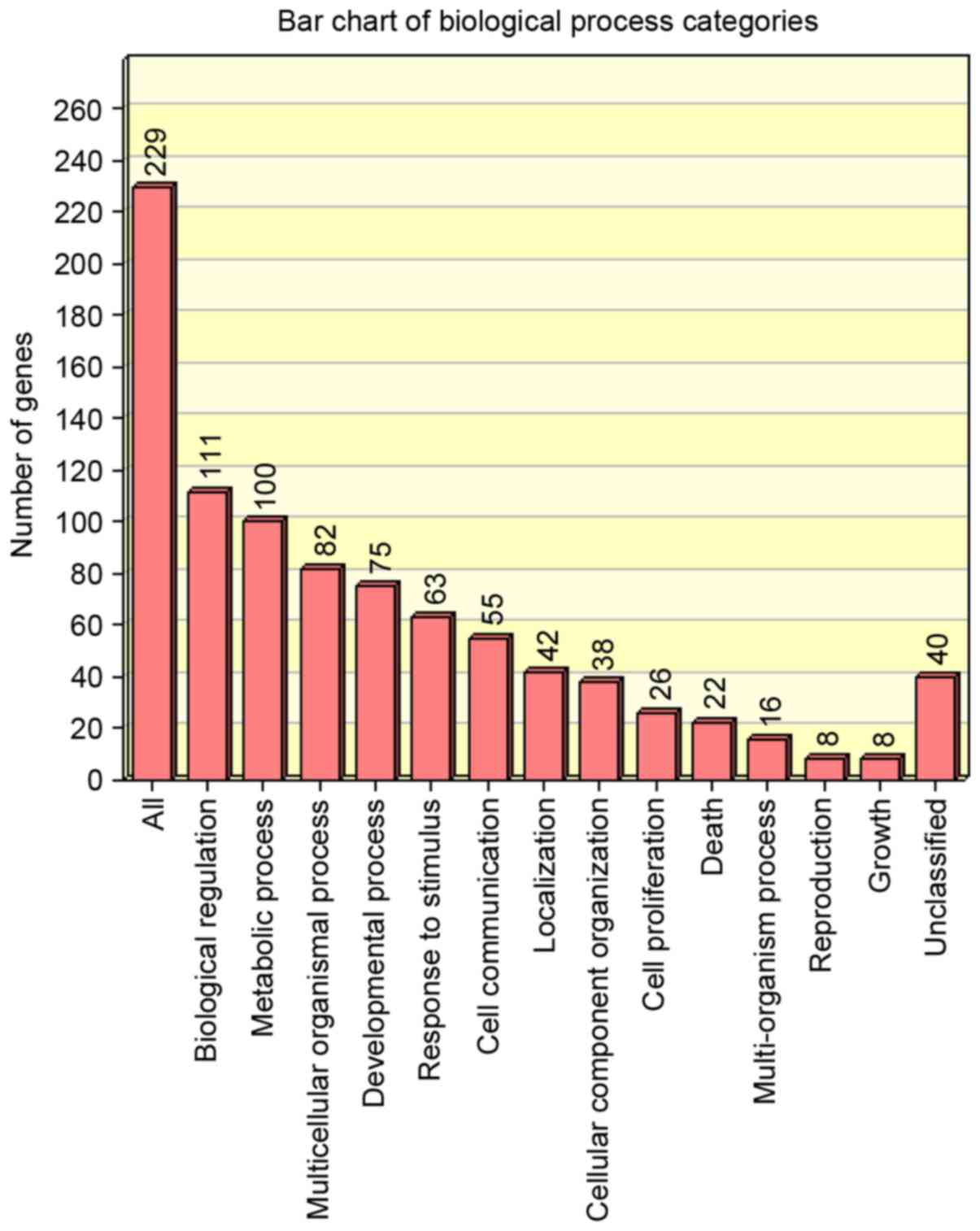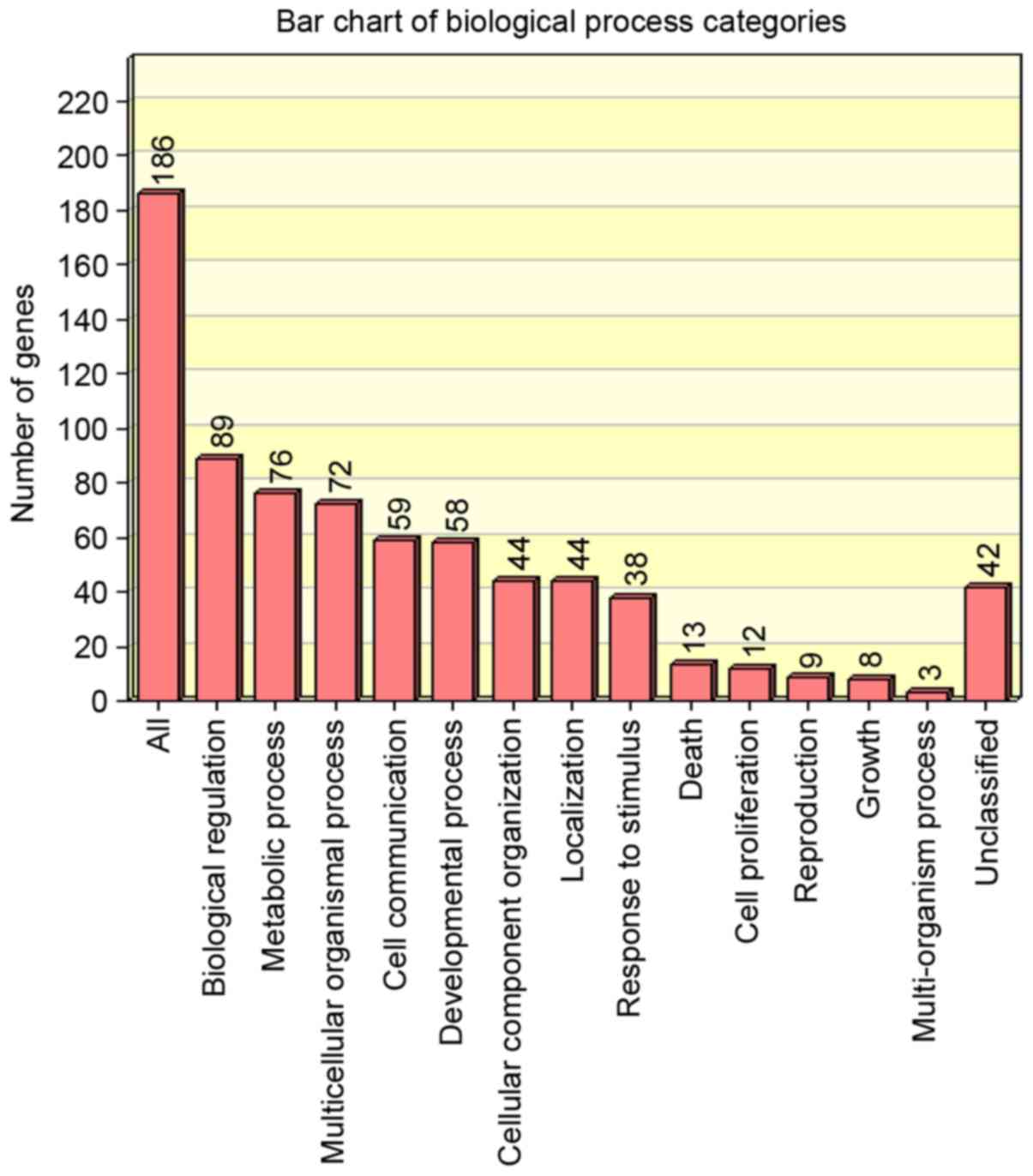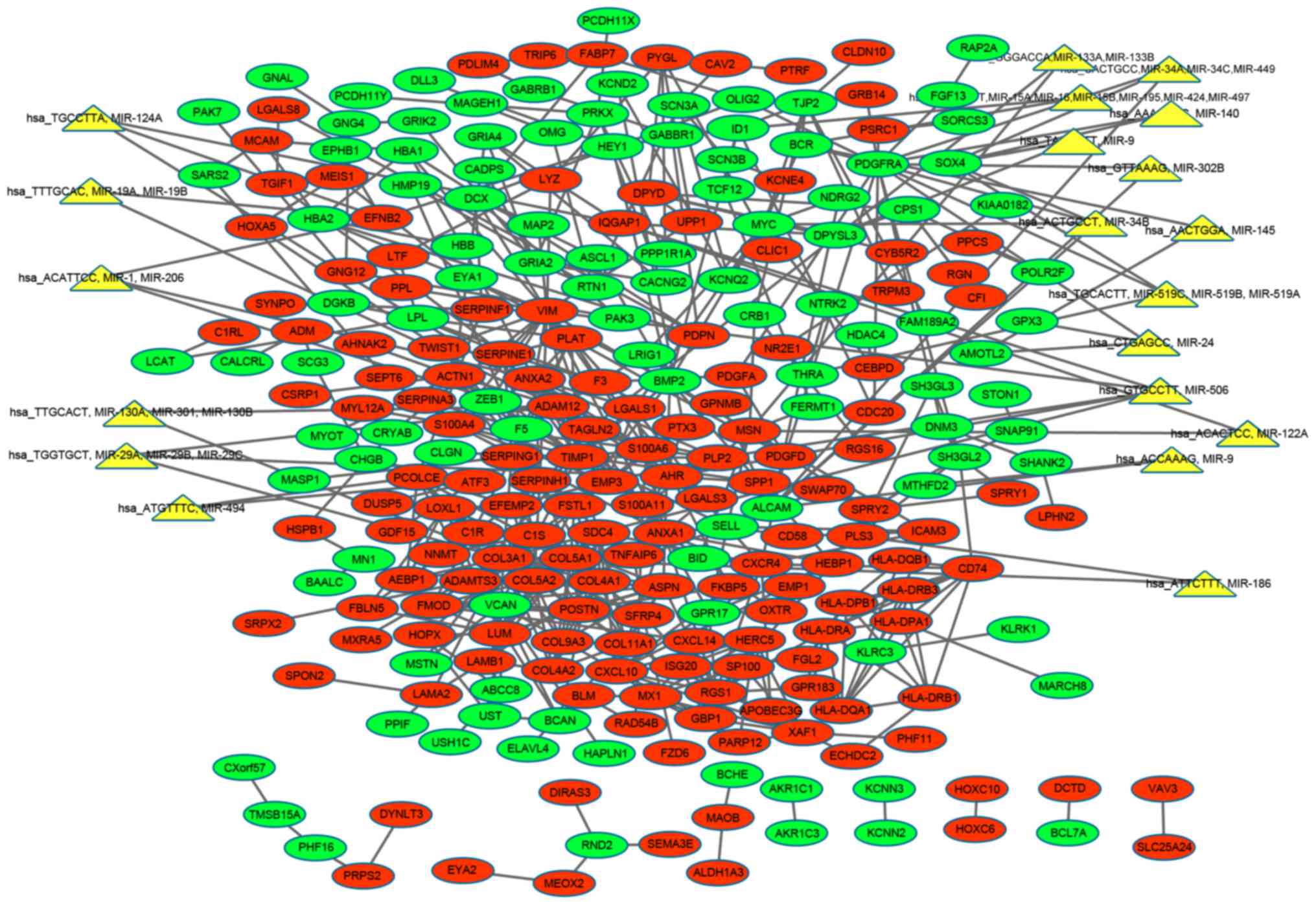Identification of key genes in glioma CpG island methylator phenotype via network analysis of gene expression data
- Authors:
- Published online on: October 19, 2017 https://doi.org/10.3892/mmr.2017.7834
- Pages: 9503-9511
-
Copyright: © Bo et al. This is an open access article distributed under the terms of Creative Commons Attribution License.
Abstract
Introduction
Malignant glioma is the most common central nervous system tumour in adults and is associated with significant morbidity and mortality (1). Gliomas are highly invasive and poorly respond to conventional treatments; therefore, further studies to support the development of therapy for them are warranted (2).
Alterations in methylation serve a critical role in the pathogenesis of numerous human malignancies, including gliomas (3). CpG island methylator phenotype (CIMP) has emerged as a distinct molecular subclass of tumours (4). It features extensive, coordinated hypermethylation at specific loci (5,6). Several key genes regulated by methylation have been previously identified. O6-methylguanine-DNA methyltransferase (MGMT), which is responsible for DNA repair, is associated with chemotherapy resistance (7). Previous studies indicated that epigenetic silencing of MGMT via promoter methylation serves an important role in the regulation of MGMT expression in gliomas (8). Bruna et al (9) demonstrated that the methylation of platelet-derived growth factor (PDGF)-B can dictate transforming growth factor-β as an oncogenic factor to promote cell proliferation in human glioma. In addition, Wiencke et al (10) reported that methylation of the phosphatase and tensin homolog promoter defines low-grade gliomas and secondary glioblastoma. Mueller et al (11) also suggested that epigenetic dysregulation of runt-related transcription factor 3 and testin is involved in glioblastoma tumorigenesis. Abnormal DNA methylation of CD133 (12) and tumor protein 53 (13) is also observed in glioma. Additionally, Turcan et al (14) indicated that isocitrate dehydrogenase 1 mutation is sufficient to establish the glioma hypermethylator phenotype. However, the identification of glioma-CIMP (G-CIMP) tumours based on gene expression data has rarely been reported (15). In the present study, gene expression profiles of CIMP-positive (CIMP+) samples were compared with those of CIMP-negative (CIMP−) samples to identify differentially expressed genes (DEGs), which were further subjected to functional enrichment analysis and network analyses. The findings of the present study may extend the understanding of the molecular mechanisms of CIMP+ glioma.
Materials and methods
Gene expression data
A gene expression data set (accession no. GSE30336) was downloaded from Gene Expression Omnibus (14), including 36 CIMP+ glioma and 16 CIMP− samples. Gene expression levels were measured using the GPL571 (HG-U133A_2) Affymetrix Human Genome U133A 2.0 Array (Affymetrix; Thermo Fisher Scientific Inc., Waltham, MA, USA). Probe annotations were also acquired.
Pretreatment and differential analysis
Raw data were pre-treated with the Robust Multichip Average method using the Affy package of R (www.bioconductor.org/packages/release/bioc/html/affy.html). Differential analysis was performed for CIMP+ vs. CIMP− using the limma package (16) of R. |Log (fold change)| >1.0 and P<0.05 were set as cut-offs for significant differential expression.
Functional enrichment analysis
The Gene Ontology (GO; www.geneontology.org/) database is a bioinformatics resource that can provide functional categorization and annotations for gene products via the use of structured, controlled vocabularies (17). The Kyoto Encyclopaedia of Genes and Genome (KEGG; www.genome.jp/kegg) is a database for systematic analysis of the functions of genes or proteins in several specific metabolic and regulatory pathways (18). Functional enrichment analyses of the GO and KEGG databases were conducted using the Database for Annotation, Visualization and Integration Discovery (david.abcc.ncifcrf.gov/) (19). The statistical method for this was based on hypergeometric distribution. P<0.05 was considered to indicate significant functions and pathways.
Construction of protein-protein interaction (PPI) network
Proteins work together to complete certain biological functions. Therefore, revealing PPI is useful in elucidating underlying molecular mechanisms. In the present study, PPI networks were constructed for upregulated and downregulated genes using information from STRING (20). Interactions with the required level of confidence (i.e., score >0.4) were retained in the network. The two networks were visualised using Cytoscape (21).
Proteins in the network were presented as ‘nodes’, and each pairwise protein interaction was represented by an undirected link and the ‘degree’ of a node corresponded to the number of interactions by the protein. ‘Degree’ was calculated for each node.
Prediction of miRNAs and construction of the whole regulatory network
Web-based Gene Set Enrichment Analysis Toolkit (WebGestalt; www.webgestalt.org/option.php) is a comprehensive and powerful analysis toolkit, which can be used for enrichment analysis and microRNA (miRNA)-target prediction by identifying miRNA-binding site motifs. In the present study, miRNAs regulating DEGs were predicted using WebGestalt (22). Count ≥2 was set as the cut-off for predicted miRNAs and the top 10 miRNAs were selected. Following miRNA-target gene network pairs using WebGestalt, PPI networks and miRNA-target gene interactions were integrated. Subsequently, the whole regulatory network was visualised using Cytoscape (21).
Results
DEGs
A total of 41,335 genes were detected and 439 DEGs between CIMP+ and CIMP− samples were identified, including 241 upregulated and 198 downregulated genes in CIMP+ samples.
Functional enrichment analysis
The GO biological pathway terms enriched for the 241 upregulated genes in CIMP+ samples could be divided into 13 clusters. They were associated with extracellular matrix organisation, defence response, immune response, collagen fibril organisation, and regulation of cell motion. The top 10 terms are listed in Table I.
The GO biological pathway terms enriched for the 198 downregulated genes were divided into 12 clusters. They were associated with cell adhesion, sensory organ development, system process regulation, neuron differentiation and membrane organisation. The top 10 terms are listed in Table I.
KEGG pathway enrichment analysis revealed 16 significant pathways associated with upregulated genes (Table II), including focal adhesion (hsa04510), asthma (hsa05310), ECM-receptor interaction (hsa04512), intestinal immune network for immunoglobulin A production (hsa04672) and allograft rejection (hsa05330). No significant pathway was identified for the downregulated genes.
PPI networks of the DEGs
A PPI network containing 134 nodes and 314 edges was constructed for the upregulated genes (Fig. 1), whereas a PPI network consisting of 85 nodes and 80 edges was obtained for the downregulated genes (Fig. 2).
The top ten nodes with a high degree in the up and downregulated PPI networks are listed in Table III. The top five nodes in the network of upregulated genes were collagen type III α1 (COL3A1), collagen type V α2 (COL5A2), TIMP metallopeptidase inhibitor 1 (TIMP1), collagen type V α1 (COL5A1) and vimentin (VIM). In the network of downregulated genes, the top six nodes were glutamate receptor ionotropic AMPA2 (GRIA2), bone morphogenetic protein 2 (BMP2), protein kinase X-linked (PRKX), v-myc avian myelocytomatosis viral oncogene homolog (MYC), tight junction protein 2 (TJP2) and platelet-derived growth factor receptor α polypeptide (PDGFRA).
Table III.Top 10 nodes with a high degree in the up and downregulated protein-protein interaction network. |
miRNA prediction and regulatory network analysis
The distribution of upregulated and downregulated genes in biological processes was analysed using WebGestalt (Figs. 3 and 4, respectively). The regulatory miRNAs of DEGs were also predicted (Table IV). Among these predicted miRNAs, miRNA-506 and miR-34b targeted the most DEGs in the up- and downregulated regulatory networks. In the upregulated regulatory network, miRNA-506 (miR-506) regulated five upregulated genes: VIM, aryl hydrocarbon receptor, proteolipid protein 2, IQ motif-containing GTPase activating protein 1 (IQGAP1) and syndecan 4. In the downregulated regulatory network, miR-34b regulated four downregulated genes: Sex determining region Y-box 4, PDGFRA, activated leukocyte cell adhesion molecule (ALCAM) and MYC. All predicted miRNAs with their target DEG pairs are presented in the regulatory network (Fig. 5).
Discussion
In the present study, a total of 439 DEGs were identified, including 241 upregulated and 198 downregulated genes. Functional enrichment analysis predicted that upregulated genes were associated with extracellular matrix organisation, defence response, immune response, collagen fibril organisation and regulation of cell motion, whereas downregulated genes were associated with cell adhesion, sensory organ development, regulation of system process, neuron differentiation and membrane organisation. These findings are consistent with previous reports (23–26). Ulrich et al (27) pointed out that the mechanical rigidity of the extracellular matrix regulates the structure, motility and proliferation of glioma cells. Cell motion and cell adhesion were closely associated with the invasion of glioma cells.
In the present study, a PPI network containing 134 nodes and 314 edges was constructed for upregulated genes, whereas a PPI network consisting of 85 nodes and 80 edges was also obtained for downregulated genes. The top five nodes in the network of upregulated genes were COL3A1, COL5A2, TIMP1, COL5A1 and VIM. TIMP1, as an inhibitor of matrix metalloproteinases, can promote cell proliferation and may have anti-apoptotic function (28). Groft et al (29) reported the differential expression and localisation of TIMP-1 and TIMP-4 in human gliomas and suggested that they may contribute to the pathophysiology of human malignant gliomas. In addition, Aaberg-Jessen et al (30) demonstrated that low expression of tissue inhibitor of TIMP-1 in glioblastoma predicts longer patient survival. Serum TIMP-1 level is also regarded as an independent predictor of survival (31). VIM is a member of the intermediate filament family and functions as an organiser of numerous critical proteins involved in cell adhesion, migration and cell signalling (32). Overexpression of VIM has been reported in central nervous system tumours and it strongly correlates with accelerated tumour growth, invasion and poor prognosis (33). The top six nodes in the network of downregulated genes in the present study were GRIA2, BMP2, PRKX, MYC, TJP2 and PDGFRA. BMP2 is involved in cell differentiation. Deregulation of the BMP developmental pathway in glioblastoma-initiating cells contributes to their tumorigenicity both by desensitising cells to normal differentiation cues and converting otherwise cytostatic signals to pro-proliferative ones (34). Liu et al (35) indicated that BMP2 expression levels may be a potent tool for assessing the clinical prognosis of glioma patients. In addition, Wang et al (36) reported that c-MYC is required for the maintenance of glioma cancer stem cells. Furthermore, Jensen et al (37) demonstrated that astroglial c-MYC overexpression predisposes mice to primary malignant gliomas. Overexpression of PDGFRA has also been reported in gliomas (38,39). Taken these findings together, TIMP-1, VIM, BMP2, MYC and PDGFRA may be associated with the development of glioma.
miRNAs regulating upregulated and downregulated genes identified in the present study were predicted using WebGestalt, including miR-124a and miR-34a. miR-124a can inhibit the proliferation of glioblastoma multiforme cells and induce the differentiation of brain tumour stem cells (40). It is frequently downregulated in glioblastoma and is involved in migration and invasion (41). IQGAP1 is one of its target genes, which has been implicated in the regulation of E-cadherin-mediated cell-cell adhesion (42,43). In addition, miR-34a can inhibit glioblastoma growth by targeting multiple oncogenes (44). In the present study, we predicted that miR-34a regulates PDGFRA and ALCAM, which were downregulated in CIMP+ samples. This is noteworthy because PDGFRA is involved in tumour progression (45) and its suppression by targeting miR-34a could contribute to tumorigenesis in pro-neural malignant gliomas (46), whereas ALCAM is associated with cell adhesion and cell migration (47). Therefore, it is speculated that these miRNAs may be useful for treating gliomas but further confirmation is needed.
Although we identified several DEGs that were important to define a distinct subgroup of glioma and understand the progression of glioma CIMP, there are certain limitations in the present study. The association between DEGs and methylation level in the different CIMPs was not investigated due to the lack of information on DEGs methylation levels in the dataset used. Additionally, experimental or data verification for the DEGs identified in glioma CIMP was not conducted, and in future, samples should be divided into different CIMPs based on methylation analysis to conduct the experimental validation.
In conclusion, several key genes were identified in glioma CIMP, some of which (TIMP1, VIM, BMP2, c-MYC and PDGFRA) may be viewed as potential markers or therapeutic targets for gliomas. In addition, relevant miRNAs, such as miR-124a and miR-34a that regulate genes involved in gliomas were also detected. These findings may provide helpful guidance to reveal molecular mechanisms underlying glioma CIMP.
Glossary
Abbreviations
Abbreviations:
|
CIMP |
CpG island methylator phenotype |
|
DEGs |
differentially expressed genes |
|
PPI |
protein-protein interaction |
|
MGMT |
O6-methylguanine-DNA methyltransferase |
|
PDGF |
platelet-derived growth factor |
|
GO |
Gene Ontology |
|
COL3A1 |
collagen type III α1 |
|
COL5A2 |
collagen type V α2 |
|
TIMP1 |
TIMP metallopeptidase inhibitor 1 |
|
COL5A1 |
collagen type V α1 |
|
VIM |
vimentin |
|
GRIA2 |
glutamate receptor ionotropic AMPA2 |
|
BMP2 |
bone morphogenetic protein 2 |
|
PRKX |
protein kinase X-linked |
|
MYC |
v-myc avian myelocytomatosis viral oncogene homolog |
|
TJP2 |
tight junction protein 2 |
|
PDGFRA |
platelet-derived growth factor receptor α polypeptide |
|
IQGAP1 |
IQ motif-containing GTPase activating protein 1 |
|
ALCAM |
activated leukocyte cell adhesion molecule |
References
|
Kim TY, Zhong S, Fields CR, Kim JH and Robertson KD: Epigenomic profiling reveals novel and frequent targets of aberrant DNA methylation-mediated silencing in malignant glioma. Cancer Res. 66:7490–7501. 2006. View Article : Google Scholar : PubMed/NCBI | |
|
Pan D, Wei X, Liu M, Feng S, Tian X, Feng X and Zhang X: Adenovirus mediated transfer of p53, GM-CSF and B7-1 suppresses growth and enhances immunogenicity of glioma cells. Neurol Res. 32:502–509. 2010. View Article : Google Scholar : PubMed/NCBI | |
|
Christensen BC, Smith AA, Zheng S, Koestler DC, Houseman EA, Marsit CJ, Wiemels JL, Nelson HH, Karagas MR, Wrensch MR, et al: DNA methylation, isocitrate dehydrogenase mutation, and survival in glioma. J Natl Cancer Inst. 103:143–153. 2011. View Article : Google Scholar : PubMed/NCBI | |
|
Noushmehr H, Weisenberger DJ, Diefes K, Phillips HS, Pujara K, Berman BP, Pan F, Pelloski CE, Sulman EP, Bhat KP, et al: Identification of a CpG island methylator phenotype that defines a distinct subgroup of glioma. Cancer Cell. 17:510–522. 2010. View Article : Google Scholar : PubMed/NCBI | |
|
Fang F, Turcan S, Rimner A, Kaufman A, Giri D, Morris LG, Shen R, Seshan V, Mo Q, Heguy A, et al: Breast cancer methylomes establish an epigenomic foundation for metastasis. Sci Transl Med. 3:75ra252011. View Article : Google Scholar : PubMed/NCBI | |
|
Cheng YW, Pincas H, Bacolod MD, Schemmann G, Giardina SF, Huang J, Barral S, Idrees K, Khan SA, Zeng Z, et al: CpG island methylator phenotype associates with low-degree chromosomal abnormalities in colorectal cancer. Clin Cancer Res. 14:6005–6013. 2008. View Article : Google Scholar : PubMed/NCBI | |
|
Weller M, Stupp R, Reifenberger G, Brandes AA, van den Bent MJ, Wick W and Hegi ME: MGMT promoter methylation in malignant gliomas: Ready for personalized medicine? Nat Rev Neurol. 6:39–51. 2010. View Article : Google Scholar : PubMed/NCBI | |
|
Hegi ME, Liu L, Herman JG, Stupp R, Wick W, Weller M, Mehta MP and Gilbert MR: Correlation of O6-methylguanine methyltransferase (MGMT) promoter methylation with clinical outcomes in glioblastoma and clinical strategies to modulate MGMT activity. J Clin Oncol. 26:4189–4199. 2008. View Article : Google Scholar : PubMed/NCBI | |
|
Bruna A, Darken RS, Rojo F, Ocaña A, Peñuelas S, Arias A, Paris R, Tortosa A, Mora J, Baselga J and Seoane J: High TGFbeta-Smad activity confers poor prognosis in glioma patients and promotes cell proliferation depending on the methylation of the PDGF-B gene. Cancer Cell. 11:147–160. 2007. View Article : Google Scholar : PubMed/NCBI | |
|
Wiencke JK, Zheng S, Jelluma N, Tihan T, Vandenberg S, Tamgüney T, Baumber R, Parsons R, Lamborn KR, Berger MS, et al: Methylation of the PTEN promoter defines low-grade gliomas and secondary glioblastoma. Neuro Oncol. 9:271–279. 2007. View Article : Google Scholar : PubMed/NCBI | |
|
Mueller W, Nutt CL, Ehrich M, Riemenschneider MJ, Von Deimling A, Van Den Boom D and Louis DN: Downregulation of RUNX3 and TES by hypermethylation in glioblastoma. Oncogene. 26:583–593. 2007. View Article : Google Scholar : PubMed/NCBI | |
|
Yi JM, Tsai HC, Glöckner SC, Lin S, Ohm JE, Easwaran H, James CD, Costello JF, Riggins G, Eberhart CG, et al: Abnormal DNA methylation of CD133 in colorectal and glioblastoma tumors. Cancer Res. 68:8094–8103. 2008. View Article : Google Scholar : PubMed/NCBI | |
|
Amatya VJ, Naumann U, Weller M and Ohgaki H: TP53 promoter methylation in human gliomas. Acta Neuropathol. 110:178–184. 2005. View Article : Google Scholar : PubMed/NCBI | |
|
Turcan S, Rohle D, Goenka A, Walsh LA, Fang F, Yilmaz E, Campos C, Fabius AW, Lu C, Ward PS, et al: IDH1 mutation is sufficient to establish the glioma hypermethylator phenotype. Nature. 483:479–483. 2012. View Article : Google Scholar : PubMed/NCBI | |
|
Baysan M, Bozdag S, Cam MC, Kotliarova S, Ahn S, Walling J, Killian JK, Stevenson H, Meltzer P and Fine HA: G-cimp status prediction of glioblastoma samples using mRNA expression data. PLoS One. 7:e478392012. View Article : Google Scholar : PubMed/NCBI | |
|
Diboun I, Wernisch L, Orengo CA and Koltzenburg M: Microarray analysis after RNA amplification can detect pronounced differences in gene expression using limma. BMC Genomics. 7:2522006. View Article : Google Scholar : PubMed/NCBI | |
|
Gene Ontology Consortium, ; Blake JA, Dolan M, Drabkin H, Hill DP, Li N, Sitnikov D, Bridges S, Burgess S, Buza T, et al: Gene Ontology annotations and resources. Nucleic Acids Res. 41(Database issue): D530–D535. 2013.PubMed/NCBI | |
|
Kanehisa M and Goto S: KEGG: Kyoto Encyclopedia of Genes and Genomes. Nucleic Acids Res. 28:27–30. 2000. View Article : Google Scholar : PubMed/NCBI | |
|
Huang DW, Sherman BT, Tan Q, Collins JR, Alvord WG, Roayaei J, Stephens R, Baseler MW, Lane HC and Lempicki RA: The DAVID gene functional classification tool: A novel biological module-centric algorithm to functionally analyze large gene lists. Genome Biol. 8:R1832007. View Article : Google Scholar : PubMed/NCBI | |
|
Szklarczyk D, Franceschini A, Kuhn M, Simonovic M, Roth A, Minguez P, Doerks T, Stark M, Muller J, Bork P, et al: The STRING database in 2011: Functional interaction networks of proteins, globally integrated and scored. Nucleic Acids Res. 39(Database issue): D561–D568. 2011. View Article : Google Scholar : PubMed/NCBI | |
|
Smoot ME, Ono K, Ruscheinski J, Wang PL and Ideker T: Cytoscape 2.8: New features for data integration and network visualization. Bioinformatics. 27:431–432. 2011. View Article : Google Scholar : PubMed/NCBI | |
|
Zhang B, Kirov S and Snoddy J: WebGestalt: An integrated system for exploring gene sets in various biological contexts. Nucleic Acids Res. 33(Web server issue): W741–W748. 2005. View Article : Google Scholar : PubMed/NCBI | |
|
Yao ZQ and Lu YC: Research on molecular mechanism of human glioma and its clinical application. Chin J Cancer Biother. 15:90–94. 2008. | |
|
Huse JT and Holland EC: Targeting brain cancer: Advances in the molecular pathology of malignant glioma and medulloblastoma. Nat Rev Cancer. 10:319–331. 2010. View Article : Google Scholar : PubMed/NCBI | |
|
Clubb BH and Shivers RR: Extracellular matrix regulates microfilament and vinculin organization in C6-glioma cells. Acta Neuropathol. 91:31–40. 1996. View Article : Google Scholar : PubMed/NCBI | |
|
Bauke AC, Sasse S, Matzat T and Klämbt C: A transcriptional network controlling glial development in the Drosophila visual system. Development. 142:2184–2193. 2015. View Article : Google Scholar : PubMed/NCBI | |
|
Ulrich TA, de Juan Pardo EM and Kumar S: The mechanical rigidity of the extracellular matrix regulates the structure, motility, and proliferation of glioma cells. Cancer Res. 69:4167–4174. 2009. View Article : Google Scholar : PubMed/NCBI | |
|
Lee SJ, Yoo HJ, Bae YS, Kim HJ and Lee ST: TIMP-1 inhibits apoptosis in breast carcinoma cells via a pathway involving pertussis toxin-sensitive G protein and c-Src. Biochem Biophys Res Commun. 312:1196–1201. 2003. View Article : Google Scholar : PubMed/NCBI | |
|
Groft LL, Muzik H, Rewcastle NB, Johnston RN, Knäuper V, Lafleur MA, Forsyth PA and Edwards DR: Differential expression and localization of TIMP-1 and TIMP-4 in human gliomas. Br J Cancer. 85:55–63. 2001. View Article : Google Scholar : PubMed/NCBI | |
|
Aaberg-Jessen C, Christensen K, Offenberg H, Bartels A, Dreehsen T, Hansen S, Schrøder HD, Brünner N and Kristensen BW: Low expression of tissue inhibitor of metalloproteinases-1 (TIMP-1) in glioblastoma predicts longer patient survival. J Neurooncol. 95:117–128. 2009. View Article : Google Scholar : PubMed/NCBI | |
|
Crocker M, Ashley S, Giddings I, Petrik V, Hardcastle A, Aherne W, Pearson A, Bell BA, Zacharoulis S and Papadopoulos MC: Serum angiogenic profile of patients with glioblastoma identifies distinct tumor subtypes and shows that TIMP-1 is a prognostic factor. Neuro Oncol. 13:99–108. 2011. View Article : Google Scholar : PubMed/NCBI | |
|
Yamasaki T, Seki N, Yamada Y, Yoshino H, Hidaka H, Chiyomaru T, Nohata N, Kinoshita T, Nakagawa M and Enokida H: Tumor suppressive microRNA-138 contributes to cell migration and invasion through its targeting of vimentin in renal cell carcinoma. Int J Oncol. 41:805–817. 2012. View Article : Google Scholar : PubMed/NCBI | |
|
Satelli A and Li S: Vimentin in cancer and its potential as a molecular target for cancer therapy. Cell Mol Life Sci. 68:3033–3046. 2011. View Article : Google Scholar : PubMed/NCBI | |
|
Lee J, Son MJ, Woolard K, Donin NM, Li A, Cheng CH, Kotliarova S, Kotliarov Y, Walling J, Ahn S, et al: Epigenetic-mediated dysfunction of the bone morphogenetic protein pathway inhibits differentiation of glioblastoma-initiating cells. Cancer Cell. 13:69–80. 2008. View Article : Google Scholar : PubMed/NCBI | |
|
Liu C, Tian G, Tu Y, Fu J, Lan C and Wu N: Expression pattern and clinical prognostic relevance of bone morphogenetic protein-2 in human gliomas. Jpn J Clin Oncol. 39:625–631. 2009. View Article : Google Scholar : PubMed/NCBI | |
|
Wang J, Wang H, Li Z, Wu Q, Lathia JD, McLendon RE, Hjelmeland AB and Rich JN: c-Myc is required for maintenance of glioma cancer stem cells. PLoS One. 3:e37692008. View Article : Google Scholar : PubMed/NCBI | |
|
Jensen NA, Pedersen KM, Lihme F, Rask L, Nielsen JV, Rasmussen TE and Mitchelmore C: Astroglial c-Myc overexpression predisposes mice to primary malignant gliomas. J Biol Chem. 278:8300–8308. 2003. View Article : Google Scholar : PubMed/NCBI | |
|
Puputti M, Tynninen O, Sihto H, Blom T, Mäenpää H, Isola J, Paetau A, Joensuu H and Nupponen NN: Amplification of KIT PDGFRA, VEGFR2, and EGFR in gliomas. Mol Cancer Res. 4:927–934. 2006. View Article : Google Scholar : PubMed/NCBI | |
|
Giannini C, Sarkaria JN, Saito A, Uhm JH, Galanis E, Carlson BL, Schroeder MA and James CD: Patient tumor EGFR and PDGFRA gene amplifications retained in an invasive intracranial xenograft model of glioblastoma multiforme. Neuro Oncol. 7:164–176. 2005. View Article : Google Scholar : PubMed/NCBI | |
|
Silber J, Lim DA, Petritsch C, Persson AI, Maunakea AK, Yu M, Vandenberg SR, Ginzinger DG, James CD, Costello JF, et al: miR-124 and miR-137 inhibit proliferation of glioblastoma multiforme cells and induce differentiation of brain tumor stem cells. BMC Med. 6:142008. View Article : Google Scholar : PubMed/NCBI | |
|
Fowler A, Thomson D, Giles K, Maleki S, Mreich E, Wheeler H, Leedman P, Biggs M, Cook R, Little N, et al: miR-124a is frequently down-regulated in glioblastoma and is involved in migration and invasion. Eur J Cancer. 47:953–963. 2011. View Article : Google Scholar : PubMed/NCBI | |
|
Kuroda S, Fukata M, Nakagawa M, Fujii K, Nakamura T, Ookubo T, Izawa I, Nagase T, Nomura N, Tani H, et al: Role of IQGAP1, a target of the small GTPases Cdc42 and Rac1, in regulation of E-cadherin-mediated cell-cell adhesion. Science. 281:832–835. 1998. View Article : Google Scholar : PubMed/NCBI | |
|
Noritake J, Watanabe T, Sato K, Wang S and Kaibuchi K: IQGAP1: A key regulator of adhesion and migration. J Cell Sci. 118:2085–2092. 2005. View Article : Google Scholar : PubMed/NCBI | |
|
Li Y, Guessous F, Zhang Y, Dipierro C, Kefas B, Johnson E, Marcinkiewicz L, Jiang J, Yang Y, Schmittgen TD, et al: MicroRNA-34a inhibits glioblastoma growth by targeting multiple oncogenes. Cancer Res. 69:7569–7576. 2009. View Article : Google Scholar : PubMed/NCBI | |
|
Heinrich MC, Corless CL, Duensing A, Mcgreevey L, Chen CJ, Joseph N, Singer S, Griffith DJ, Haley A, Town A, et al: PDGFRA activating mutations in gastrointestinal stromal tumors. Science. 299:708–710. 2003. View Article : Google Scholar : PubMed/NCBI | |
|
Silber J, Jacobsen A, Ozawa T, Harinath G, Holland EC, Sander C and Huse JT: Abstract B15: Repression of PDGFRA-targeting miR-34a promotes tumorigenesis in proneural malignant gliomas. Cancer Res. 72 Suppl 2:B152012. View Article : Google Scholar | |
|
Swart GW: Activated leukocyte cell adhesion molecule (CD166/ALCAM): Developmental and mechanistic aspects of cell clustering and cell migration. Eur J Cell Biol. 81:313–321. 2002. View Article : Google Scholar : PubMed/NCBI |



